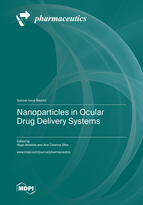Nanoparticles in Ocular Drug Delivery Systems
A special issue of Pharmaceutics (ISSN 1999-4923). This special issue belongs to the section "Nanomedicine and Nanotechnology".
Deadline for manuscript submissions: closed (15 December 2022) | Viewed by 32728
Special Issue Editors
2. Mesosystem Investigação & Investimentos by Spinpark, Barco, 4805-017 Guimarães, Portugal
Interests: prolonged release; colloidal dispersions; solid lipid nanoparticles; nanostructured lipid carriers; pharmaceutical industry; medical devices; cosmetic products
Special Issues, Collections and Topics in MDPI journals
2. Associate Laboratory i4HB - Institute for Health and Bioeconomy, Faculty of Pharmacy, University of Porto, 4050-313 Porto, Portugal
3. FP-I3ID (Instituto de Investigação, Inovação e Desenvolvimento), FP-BHS (Biomedical and Health Sciences Research Unit), Faculty of Health Sciences, University Fernando Pessoa, 4249-004 Porto, Portugal
Interests: nasal and cutaneous drug delivery; nose-to-brain delivery; lipid nanoparticles; biopharmaceuticals; biological medicines; advanced therapy medicinal products (ATMPs)
Special Issues, Collections and Topics in MDPI journals
Special Issue Information
Dear Colleagues,
Conventional ophthalmic formulations lack a prolonged drug release effect and mucoadhesive properties, decreasing their residence time in the precorneal area and, therefore, in drug penetration across ocular tissues, presenting a low bioavailability with a consequent reduction in the therapeutic efficacy. These limitations are related to the physiological mechanisms of the eye, for example, the diluting effect of formulations exerted by the tear fluid, constant turnover of the tear fluid, blink reflex, limited capacity of the conjunctival sac, and drainage of formulations applied by gravity.
To increase the residence time of formulations on the surface of ocular tissues and increase their ability to penetrate these tissues, different strategies can be used, namely, the use of viscosifying agents, mucoadhesive polymers, stimuli-responsive polymers, microparticles, and colloidal carriers (e.g., micelles, liposomes, nanosuspensions, nanoemulsions, polymeric, and lipid nanoparticles). This Special Issue combines the latest research and review works reporting the use of nanoparticles in ophthalmic formulations to increase their bioavailability and improve the therapeutic efficacy of ophthalmic formulations.
Dr. Hugo Almeida
Dr. Ana Catarina Silva
Guest Editors
Manuscript Submission Information
Manuscripts should be submitted online at www.mdpi.com by registering and logging in to this website. Once you are registered, click here to go to the submission form. Manuscripts can be submitted until the deadline. All submissions that pass pre-check are peer-reviewed. Accepted papers will be published continuously in the journal (as soon as accepted) and will be listed together on the special issue website. Research articles, review articles as well as short communications are invited. For planned papers, a title and short abstract (about 100 words) can be sent to the Editorial Office for announcement on this website.
Submitted manuscripts should not have been published previously, nor be under consideration for publication elsewhere (except conference proceedings papers). All manuscripts are thoroughly refereed through a single-blind peer-review process. A guide for authors and other relevant information for submission of manuscripts is available on the Instructions for Authors page. Pharmaceutics is an international peer-reviewed open access monthly journal published by MDPI.
Please visit the Instructions for Authors page before submitting a manuscript. The Article Processing Charge (APC) for publication in this open access journal is 2900 CHF (Swiss Francs). Submitted papers should be well formatted and use good English. Authors may use MDPI's English editing service prior to publication or during author revisions.
Keywords
- ocular drug delivery
- ophthalmic formulations
- eye drops
- prolonged release
- colloidal dispersions
- solid lipid nanoparticles








